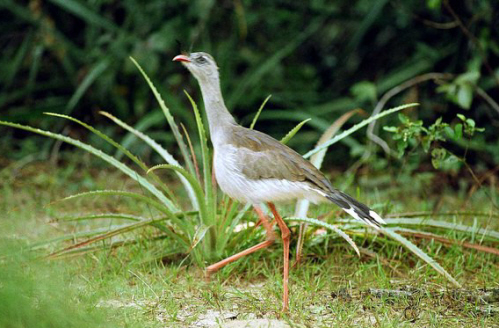Birdingpals Trip Report
Trip Report Brazil March 09 to 15/2006
by Knud Rasmussen
When I was planning my next trip to Argentina, I decided to do something I had always wanted to do: visit Brazil.
Brazil is also a very large country and with limited time we had to make a decision where to go, especially, because this is not the best time to visit
(but we wanted to escape at least some of the Canadian winter). I had always wanted to visit the Pantanal in Mato Grosso de Sul, but this is not an easy
place to get to; transportation is expensive and complicated so I started by looking at places east of Sao Paulo on the Atlantic coast, also a great
place to visit. However, when I was putting my budget together the price difference turned out to be much less than first thought, so we decided to go
for the Pantanal.
The Pantanal is located in the south-east of the Brazilian Central High Plateau where many rivers flow in to a huge plain. The Pantanal Mato-Grosso floods
annually and in 2000 was proclaimed a nature preserve by UNESCO. With more than 650 species of birds and rich in other wildlife, it is an exiting place to
visit.
I had a listing on Birdingpal for a birder friendly lodging called Fazenda Barranco Alto eco lodge located on the banks of the Rio Negro, so I contacted
them and made arrangements to visit.
Visit their web site
March 08/09
We left Toronto in the evening on an Air Canada direct flight to Sao Paulo and arrived early in the morning. We cleared customs without any problems. In
the afternoon we have a flight to Campo Grande where a small plane will pick us up and fly us to Fazendo Barranco Alto.
To catch this flight, we have to take a one hour bus ride to the domestic airport and we get a glimpse of what Sao Paulo is all about. It’s the largest
city in South America, and has more high rise apartment buildings than I have ever seen in one place in my travels. Interestingly enough, I saw no birds on
the way. When we arrived at the domestic airport we got an idea about how things work in Brazil. The bus is full of passengers and their luggage and it’s a
free for all to get yours. You can’t be too timid and I finally retrieve ours and we make our way to the check-in counter were you have to “fight” again.
After check-in, we have our first Brazilian lunch in the airport restaurant. Good but with a couple of beers the bill came to $70: not cheap.
When we arrived in Campo Grande, there is no sign of the pilot to take us to the lodge. Language is a bit of a problem, but I find a young woman on the
Linhas Aereas counter who speaks English and is extremely helpful. I did have some correspondence from the lodge indicating that if the pilot thought it
was too risky to take off for the ranch they would make arrangements for us in a local hotel. We tried to contact the ranch without success, so we took a
taxi to the hotel which did have a reservation for us.
March 10
The next morning Lucas Leuzinger (the owner of the lodge) and Ronnie (pronounced Honnie) the pilot are waiting for me in the lobby. It had been too late to
attempt a landing at the lodge last night and Lucas had been in court the day before they just forgot to tell us.
With all of our luggage (for five weeks) we drive to a small airfield and somehow the luggage, groceries and four people pile into a small one prop plane
and we are off to Fazenda Barranco Alto.
"Ronnie the Pilot"
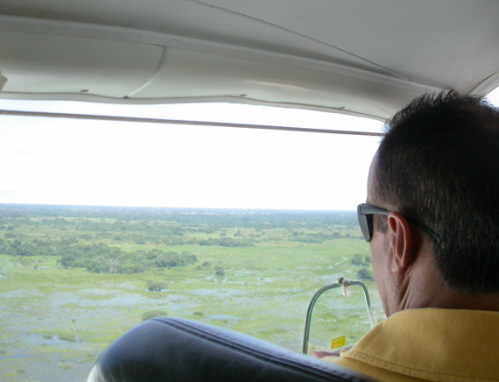
It’s a beautiful day and flying at an altitude of about 3000 feet, we have a great view of the changing landscape before landing at the ranch airfield.
Here, we meet Lucas’s wife Marina and two daughters, Letiticia and Emilia, and are transferred to a truck driven by Fernando, Lucas’s right hand and driven to the
guesthouse to check in.5
"Under the Mango Tree"
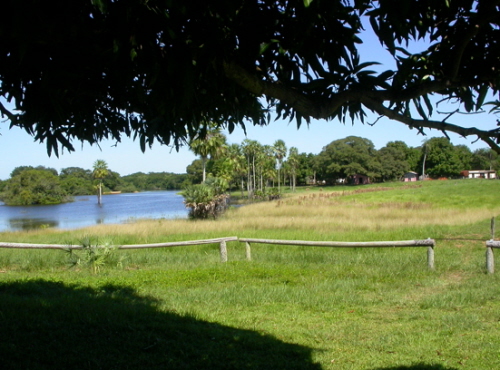
"The Guesthouse"
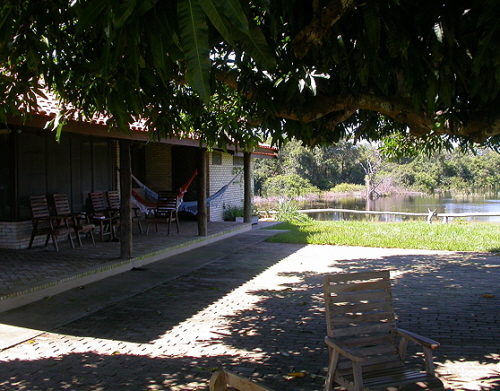
This is a beautiful place and right away we spot birds like Greater Rheas, Macaws and many Kingfishers. Caimans are sunning at the edge of the flooded field.
We checked in to our room and were instructed by Lucas about the rules of the establishment. The water is strangely coloured but we are ensured that it is
safe to drink, since it is first boiled and then filtered. To prove it, we had no problem what so ever during our stay and we drank a lot of water.
Lucas and Fernando take me out on Rio Negro in a small powerboat equipped with an electrical outboard to be used when we explore the flooded area. No Giant
Otters or Jaguars, but lots of birds.
Lunch and a siesta and then we get into the truck at five o’clock to go birding.
The ranch is 9000 hectares, with about a third set aside as a protected area, and 2000 head of cattle.
Leaving the buildings and driving into the forest, we encounter fresh and salt water ponds with many birds and animals. Marina spots a Fork-tailed
Flycatcher as soon as we leave the compound. As it gets dark, the insects are out in full, and using a search light we spot many nighthawks, Potoos and the
Crab-eating Fox you can call in just like a bird.
We returned to the lodge and sat down for dinner and then bed. It has been a long couple of days.
March 11
We were woken with the sun to the sound of Howler Monkeys and a family of Capybaras, (Capivara in Portuguese) the biggest rodent in the world and Greater Rhea in front of
the guest house.
"Greater Rhea"
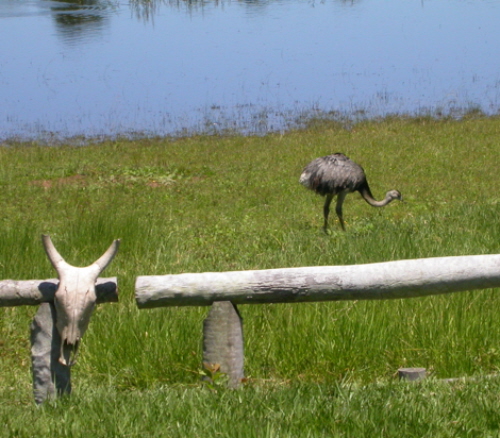
Lucas arrives with Fernando driving the truck and we are off in a different direction than last night. As soon as we start out, a Burrowing Owl inspects us,
sitting on a post a few feet away from the trail. This is not the best time of year for birdwatching, but it’s still great, with many raptors, parrots, woodpeckers
etc.
Again it’s a beautiful morning without any sign of rain, even if it is still the rainy season, and we spot many animals and the company is great even after
Lucas shows me the “burial” place for guests who did not make his standards.
"Last resting place for some guests"
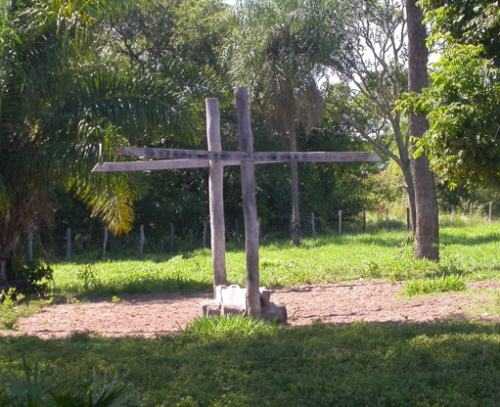
Back at the guest house we have a very nice breakfast with fresh fruit, homemade bread and jams and strong coffee.
It is quite hot and humid here and sitting under a huge mango tree in front of the guesthouse is pleasant, with a bit of a breeze. Lucas spotted three Giant
Otters in the flooded fields in front of us. Six feet long: that’s an exiting sight.
"The flooded field where we had the Giant Otters"
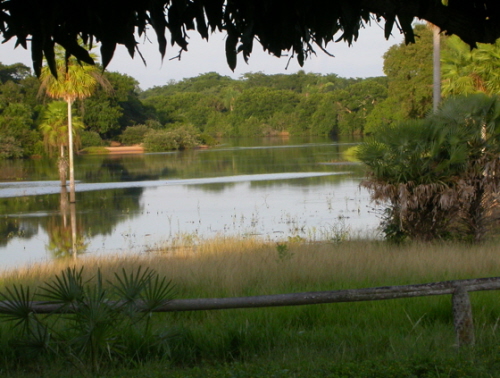
For lunch we will be joined by Pam and Tony, an English couple from Wales who will be staying for a few days.
After siesta we again get into the truck for a little night birding. As soon as dusk approaches the frogs start their concert and one locally called
“Formula 1” sounds just like the racing cars in Monte Carlo. Again we meet our friend the Crab Fox (who feed, exclusively on crabs) but this time I have an
experience like never before. Lucas tells me that you can touch a Putoo when it is perching on a pole. We spot the huge yellow eyes and stop the truck.
I get off and slowly move towards it. I reach out and stroke it’s back before it flies off. Amazing but true; you have to try it yourself!
"Great Potoo Photo by Lucas Leuzinger"
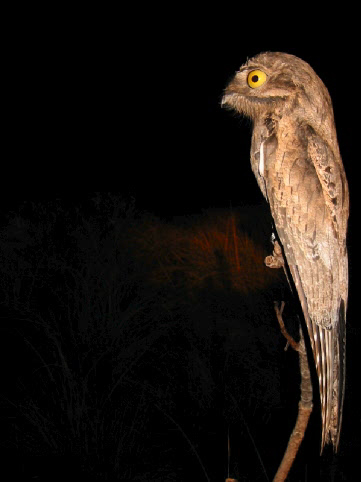
Back at the guesthouse, we dine with Pam and Tony on excellent Brazilian food. You do have to like rice to appreciate it and from the first day we arrived
and discovered hot peppers in vinegar it’s even better (we are not looking forward to Argentina, since their idea of spice is ground white pepper: only the
red meat/wine make up for it).
Lucas joins his guests for breakfast and he and Marina join us for lunch. We eat dinner on our own at the guesthouse, so they can have a little time with
their children. The guesthouse is well equipped and managed with three wives of the ranch hands cooking all meals, serving homemade juice, cool water and
the odd beer for me. A civilized place in the wetlands, with friendly people and interesting conversations.
March 12
Lucas and I take off at sunrise, and we get out of the car to walk often. Nothing better than walking in nature with a pair of binoculars and good company.
We see a lot of wild pigs, but they do not bother us. I am told that they are the only animal Lucas allows his workers to hunt; all other animals are taboo.
We see a few snakes but no five meter Anaconda.
Off in the evening again to bird in the forest. This time, we spot a young male Tapir grazing very close to the trail. Getting off the truck, we start
walking and suddenly hear the sound of stampeding cattle. Then we see them, and being city dwellers, it’s a bit intimidating. Fernando is not worried and
they run around us. Shortly after we heard a Pygmy Owl, but had no luck seeing it. It would have been a lifer for me.
I am getting used to have a caipirinha before dinner. It is a Brazilian cocktail made with crushed ice, lime and sugarcane liquor: Excellent and very
refreshing.
March 13
I tell Lucas I will be happy to go birding in the morning with just Fernando even if he speaks almost no English so he can go horseback riding with the
rest of the group who are not birders.
"Lucas and his cowgirls"
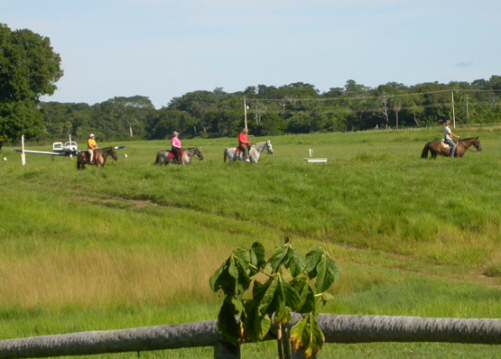
He knows the birds and has the English version of Birds of Southern South America and Antarctica to show me when I
am in doubt. Red-shouldered Macaw and Blond-crested Woodpecker are highlights of the morning.
"Red and Green Macaw Photo by Lucas Leuzinger"
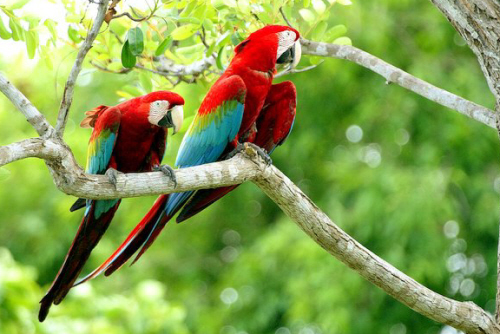
I never get tired of getting out in nature early in the morning and you always see something new. There are many vultures flying above mostly Black but
also Turkey and Yellow- head. When we arrived Lucas promised me there would be no problem showing me a King Vulture, so I automatically scan the sky when
I see vultures. But it always turns out to be a stork when I think it could be a King. Guess I have to wait for Argentina.
Back to the guesthouse for breakfast and relaxing until we take off in the evening trip.
This evening it rained very heavily and I almost destroyed my binoculars and other birding paraphernalia, because I left them on a table in the screened in
porch.
March 14
After breakfast we are going canoeing on Rio Negro and it's oxbows vino blanco early in the morning. The equipment is located under a large tree occupied by a pair of
Hyacinthine Macaws, not afraid of us at all but very noisy and worth $50,000US on the black market. We saw and heard the Macaws often during our stay and
they are well protected together with all the other wildlife here in Fazenda Barranco Alto.
"Hyacinth Macaw Photo by Lucas Leuzinger"
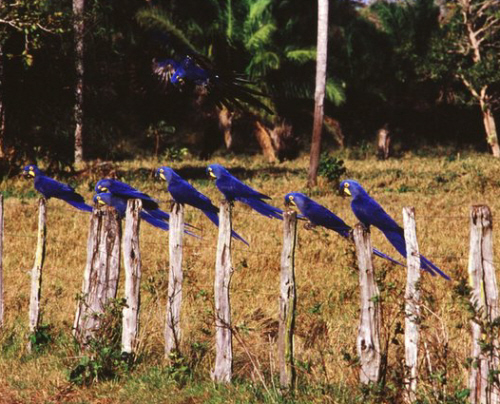
Karen and I will never make a great canoe team, but we did
manage to keep up with Pam and Tony, and Lucas in a kayak. It is difficult to bird sitting in a canoe, when the current is strong and the foliage dense.
After a couple of hours we began thinking about the ordeal of paddling against the current to get back to the ranch, but as usual Lucas, had everything
arranged to perfection even if we had to paddle up a very small creek to meet Fernando and Wellington(his 8 year old son) with the truck and a boat trailer.
"Rio Negro Photo by Tony J. Craske"
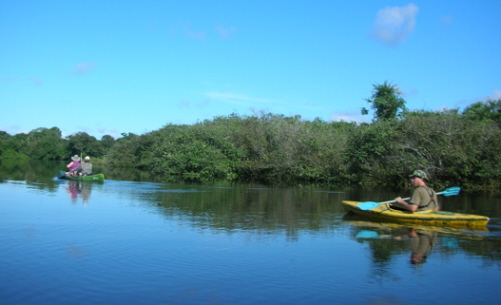
After lunch and siesta Tony and Fernando went fishing and the rest of us got on the truck for our “daily night birding”.
While fishing, Tony and Fernando clearly heard a Jaguar but did not see it. They are often seen here together with Pumas but I was not so lucky. Guess I
have to come back again sometime.
March 15
This is the last day before we leave Fazenda Barranco Alto (High bank ranch), and I take off with Fernando again. This time we visit an abandoned farm
taken over by thousands of bats (wonder if there is any Vampire here?). We saw bats every night but always flying or some sitting on cattle, and I assume
they were Vampire bats.
After lunch Ronnie, arrived to pick us up in his plane. We said our goodbyes to Marina, the kids, Lucas, Fernando and Wellington and of course Pam and Tony
who would leave the next day to spend some time in the Amazon. Lucas told me he would be harvesting his beehives tomorrow.
Both Karen and I will always remember the good times and birdwatching we had here at Fazenda Barranco Alto. It is a place well worth a visit. Thank you Marina and Lucas.
We take off with Ronnie, and tip the wing in a final farewell. As soon as we had climbed to 3500 feet Ronnie handed over the controls to me and had a
snooze until we reached Campo Grande.
We drove to the airport and boarded a flight to Sao Paulo. We only had an hour to catch our plane for Buenos Aires but as it was in the same airport and
airline, I was assured there would be no problems with us and our luggage.
Not quite so: in Brazil they take airport security very seriously and the line up was several kilometres long before reaching the check-in counter. It
took a long time and we barely made our connection. We are off and it’s raining. We must have been lucky since we only had rain one night in the Pantanal.
Here is the list of birds we saw during my visit.
Scientific name/English
RHEIDAE RHEAS
Rhea americana/Greater Rhea
TINAMIDAE TINAMOUS
Crypturellus undulatus/Undulated Tinamou
PODICIPEDIDAE GREBES
Tachybabtus dominicus/Least Grebe
PHALACROCORACIDAE
Phalacrocorax olivaceus/Neotropic Cormorant
ANHINGIDAE DARTERS
Anhinga anhinga/Anhinga
ARDEIDAE HERONS, BITTERNS
Syrigma sibilatrix/Whistling Heron
Ardea cocoi/White-necked Heron
Ardea alba/Great Egret
Bubulcus ibis/Cattle Egret
Egretta caerulea/Little Blue Heron
Egretta thula/Snowy Egret
Butorides striatus/Striated Heron
Nycticorax nycticorax/Black-crowned Night Heron
Tigrisoma lineatum Rufescent/Tiger Heron
Botarus pinnatus/Pinnated Bittern
CICCONIIDAE STORKS
Mycteria americana/American Wood Stork
Ciconia maguari/Maguari Stork
Jabiru mycteria/Jabiru Stork
TRESKIORNITHIDAE IBISES
Phimosus infuscatus/Bare-faced Ibis
Plegadis chihi/White-faced Ibis
Theristicus caerulescens/Plumbeous Ibis
Theristicus caudatus/Buff-necked Ibis
Mesembrinibis cayennensis/Green Ibis
Platalea ajaja/Roseate Spoonbill
ANATIDAE DUCKS
Dendrocygna autumnalis/Black-bellied Tree Duck
Cairina moschata/Muskovy Duck
Amazonetta brasiliensis/Brazilian Duck
ANHIMIDAE SCREAMERS
Chauna torquata/Southern Screemer
CATHARTIDAE VULTURES
Coragyps atratus/Black Vulture
Cathartes aura/Turkey Vulture
Cathartes burrovianus/Lesser yellow-headed Vulture
PANDIONIDAE OSPREYS
Pandion halietus/Osprey
ACCIPITRIDAE HAWKS,EAGLES
Rostrhamus sociabilis/Snail Kite
Geranospiza caerulescens/Crane Hawk
Heterospizias meridionalis/Savanna Hakw
Busarellus nigricollis/Black-collared Hawk
Buteo magnirostris/Roadside Hawk
FALCONIDAE FALCONS
Polyborus plancus/Crested Caracara
Milvago chimachima/Lesser yellow-headed Caracara
Falco sparverius/American Kestrel
Falco rufigularis/ Bat Falcon
CRACIDAE CURASSOWS,GUANS
Crax fasciolata/Bare-faced Curassow
Ortalis canicollis/Chaco Chachalaca
Aburria pipile/Common Piping-Guan
ARAMIDAE LIMPKIN
Aramus guarauna/Limpkin
RALLIDAE RAILS,COOTS
Aramides cajanea/Gray-necked Woodrail
Gallinula chloropus/Common Gallinule
Porphyrula martinica/Purple Gallinule
CARIAMIDAE SERIEMAS
Cariama cristata/Red-legged Seriema
JACANIDAE JACANAS
Jacana jacana/Wattled Jacana
CHARADRIIDAE PLOVERS
Vanellus chilensis/Southern Lapwing
Vanellus cayanus/Pied Lapwing
SCOLAPACIDAE SANDPIPERS
Tringa flavipes/Lesser Yellowlegs
RECURVIROSTRIDAE AVOCETS
Himantopus himantopus/Common Stilt
LARIDAE GULL,TERNS
Phaetusa simplex/Larged-billed Tern
COLUMBIDAE PIGEONS,DOVES
Columba picazuro/Picazuro Pigeon
Columba subvinacea/Ruddy Pigeon
Scardafella squammata/Scaly Dove
Columbina talpacoti/Ruddy Ground-dove
PSITTACIDAE PARROTS
Anodorhynchus hyacinthinus/Hyacinth Macaw
Ara ararauna/Blue-and-yellow Macaw
Ara chloroptera/Red-and-Green Macaw
Ara auricollis/Golden-collared Macaw
Ara nobilis/Red-shouldered Macaw
Aratinga acuticaudata/Blue-crowned Parakeet
Aratinga leucophthalmus/White-eyed Parakeet
Aratinga aurea/Peach-fronted Parakeet
Nandayus nenday/Black-hooded Parakeet
Myiopsitta monachus/Monk Parakeet
Pionus maximiliani/Scaly-headed Parrot
Amazona xanthops/Yellow-faced Amazon
CUCULIDAE CUCKOOS
Piaya cayana/Squirrel Cuckoo
Crotophaga major/Greater Ani
Crotophaga ani/Smooth-billed Ani
Guira guira/Guira Cuckoo
STRIGIDAE OWLS
Athene cunicularia/Burrowing Owl
NYCTIBIIDAE POTOOS
Nyctibius griseus/Common Potoo
Nyctibius grandis/Great Potoo
CAPRIMULGIDAE NIGHTJARS
Podager nacunda/Nacunda Nighthawk
Nyctidromus albicollis/Pauraque
Caprimulgus parvulus/Little Nightjar
APODIDAE SWIFTS
Chaetura andrei/Ashy-tailed Swift
TROCHILIDAE HUMMINGBIRDS
Hylocharis chrysura/Gilded Hummingbird
TROGONIDAE TROGONS
Trogon curucui/Blue-crowned Trogon
ALCEDINIDAE KINGFISHERS
Ceryle torquata/Ringed Kingfisher
Chloroceryle amazona/Amazon Kingfisher
Chloroceryle americana/Green Kingfisher
Chloroceryle indae/Green-and-rufous Kingfisher
Chloroceryle aenea/Pygmy Kingfisher
GALBULIDAE JACAMARS
Galbula ruficauda/Rufous-tailed Jacamar
MOMOTIDAE MOTMOTS
Momotus momota/Blue-crowned Motmot
RAMPHASTIDAE TOUCANS
Pteroglossus castanotis/Chestnut-eared Aracari
Ramphastos toco/Toco Toucan
PICIDAE WOODPECKERS
Colaptes campestris/Campo Flicker
Celeus lugubris/Pale-crested Woodpecker
Celeus flavescens/Blond-crested Woodpecker
Dryocopus lineatus/Lineated Woodpecker
Melanerpes candidus/White Woodpecker
Veniliornis passerinus/Little Woodpecker
Campephilus melanoleucos/Crimson-crested Woodpecker
DENDROCOLAPTIDAE WOODCREEPERS
Lepidocolaptes angustirostris/Narrow-billed Woodcreeper
FURNARIIDAE OVENBIRDS
Furnarius leucopus/Pale-legged Hornero
Furnarius rufus/Rufous Hornero
Pseudoseisura unirufa/Rufous Cacholote
FORMICARIIDAE ANTBIRDS
Pyriglena leucoptera/White-shouldered Fire-eye
TYRANNIDAE FLYCATCHERS
Suiriri suiriri/Suiriri Flycather
Pyrocephalus rubinus/Vermillion Flycatcher
Xolmis velata/White-rumped Monjita
Machetornis rixosus/Cattle Tyrant
Fluvicola leucocephala/White-headed Marsh-tyrant
Casiornis rufa/Rufous Casiornis
Myiarchus swainsoni/Swainson's Flycatcher
Pitangus sulphuratus/Great Kiskadee
Pitangus lictor/Lesser Kiskadee
Tyrannus savana/Fork-tailed Flycatcher
Tityra inquisitor/Black-crowned Tityra
HIRUNDINIDAE SWALLOWS
Stelgidopteryx ruficollis/Rough-winged Swallow
CORVIDAE JAYS
Cyanocorax cyanomelas/Purplish Jay
Cyanocorax cristatellus/Curl-crested Jay
Cyanocorax chrysops/Plush-crested Jay
MIMIDAE MOCKINGBIRDS
Mimus saturninus/Chalk-browed Mockingbird
TURDIDAE THRUSHES
Turdus rufiventris/Rufous-bellied Thrush
ICTERIDAE NW BLACKBIRDS
Gnorimopsar chopi/Chopi Blackbird
Molothrus badius/Bay-winged Cowbird
Molothrus bonariensis/Shiny Cowbird
Scaphidura oryzivora/Giant Cowbird
Icterus jamacaii Troupial
Cacicus solitarius/Solitary Cacique
Psarocolius decumanus/Crested Oropendola
THRAUPIDAE TANAGERS
Thraupis palmarum/Palm Tanager
Thraupis sayaca/Sayaca Tanager
Ramphocelus carbo/Silver-beaked Tanager
FRINGILLIDAE FINCHES
Saltator atricollis/Black-throated Saltator
Paroaria capitata/Yellow-billed Cardinal
Ammodramus humeralis/
Grassland Sparrow
A few more of Lucas's birds
"Toco Toucan Photo by Lucas Leuzinger"

"Common Piping-Guan Photo by Lucas Leuzinger"
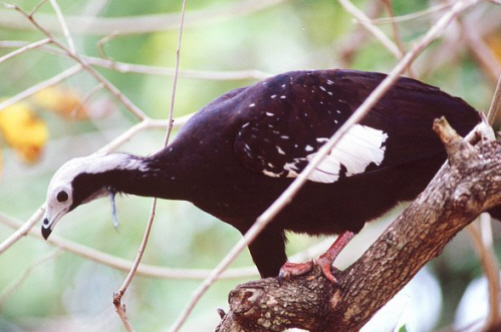
"Red-legged Seriema Photo by Lucas Leuzinger"
